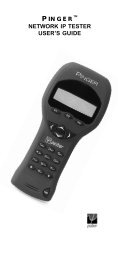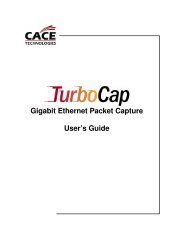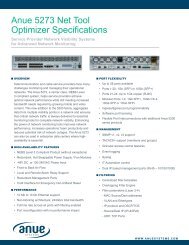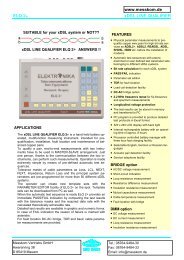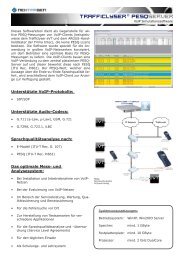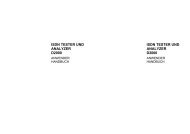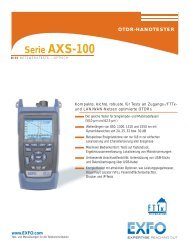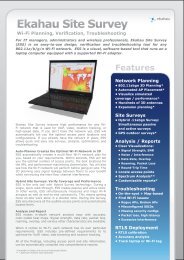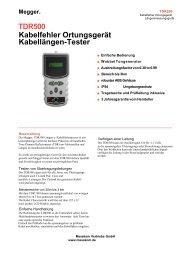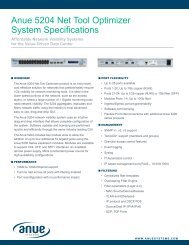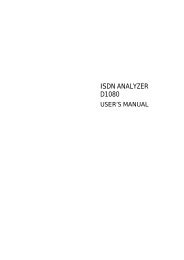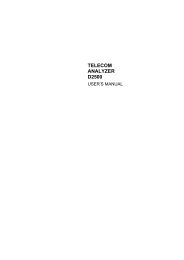Agilent Technologies N2600A WireScope 350 User's ... - messkom.de
Agilent Technologies N2600A WireScope 350 User's ... - messkom.de
Agilent Technologies N2600A WireScope 350 User's ... - messkom.de
You also want an ePaper? Increase the reach of your titles
YUMPU automatically turns print PDFs into web optimized ePapers that Google loves.
����������������������<br />
��������������������<br />
4−6<br />
1 Insert a Fiber SmartProbe + in the <strong>WireScope</strong> and a Fiber<br />
SmartProbe + in the DualRemote. They should both be multimo<strong>de</strong>.<br />
2 Connect a single fiber of each of two duplex test jumpers to the two<br />
Fiber SmartProbes + with the transmitter of each connected to the<br />
<strong>de</strong>tector of the other with no coupler.<br />
3 Turn on the <strong>WireScope</strong> and DualRemote.<br />
4 On the Fiber Main Menu, press Calibration. The Fiber Calibration<br />
screen displays as above.<br />
5 Choose Double En<strong>de</strong>d, and press Next. the Fiber Detection screen<br />
displays as above.<br />
6 When the message below the diagram reads, “Ready to Calibrate,”<br />
press OK. The Calibration window opens.<br />
7 When the window reads, “Calibration Successful,” press OK in the<br />
window. The Fiber Main Menu displays. Leave the transmitter<br />
connection to the Fiber SmartProbes intact. Remove both <strong>de</strong>tector<br />
connections and replace with the previously unused fiber of the<br />
duplex test jumper on each probe.<br />
Method C<br />
Method C is recommen<strong>de</strong>d for multi-fiber and small form factor (SFF)<br />
connectors.<br />
����� �������Ã���Ã���������������Ã����������Ã���Ã���������Ã�����������Ã������Ã����Ã���Ã����Ã<br />
��������Ã���Ã������Ã���������Ã����Ã��Ã���Ã��������Ã�����Ã�������Ã���à ��������Ã���Ã<br />
�������������� ������ �����<br />
1 Insert a Fiber SmartProbe + in the <strong>WireScope</strong> and a Fiber<br />
SmartProbe + in the DualRemote. They should both be either<br />
singlemo<strong>de</strong> or multimo<strong>de</strong>.<br />
����� ����������Ã�����Ã�����������Ã���Ã�Ã�����Ã�����Ã������Ã����Ã��������Ã�������Ã��Ã������Ã<br />
����Ã������Ã�����������Ã��Ã�������Ã����Ã����������Ã�����Ã�������Ã������Ã�������Ã���Ã<br />
�������Ã����Ã��Ã���Ã���������Ã����Ã�����������Ã��Ã������Ã���Ã����Ã����Ã�������Ã���Ã����Ã<br />
�����������������<br />
2 Connect special ST or SC to multi-fiber/SFF test jumpers to the two<br />
Fiber SmartProbes. These special transition jumpers are available<br />
from the connector manufacturers.<br />
3 Connect the test jumpers to each other, using a special reference<br />
jumper which mates with the multi-fiber/SFF connector. Special<br />
reference jumpers are manufacturer specific. Contact the connector<br />
manufacturer for <strong>de</strong>tails. Connect the <strong>WireScope</strong> transmitter to the<br />
DualRemote <strong>de</strong>tector, and vice versa.<br />
4 Turn on the <strong>WireScope</strong> and DualRemote, if necessary.<br />
5 On the Fiber Main Menu, press Calibration. The Fiber Calibration<br />
screen displays as above.<br />
6 Choose Double En<strong>de</strong>d, and press Next. the Fiber Detection screen<br />
displays as above.<br />
7 When the message below the diagram reads, “Ready to Calibrate,”<br />
press OK. The Calibration window opens.



